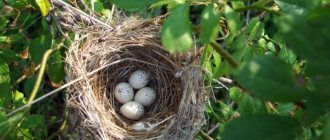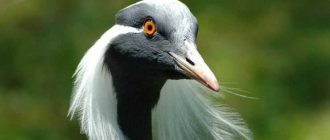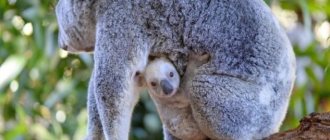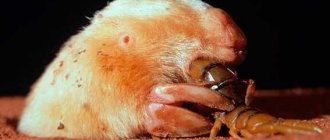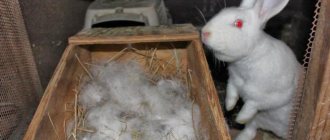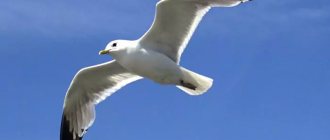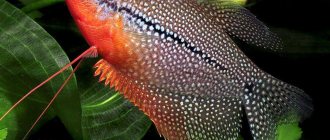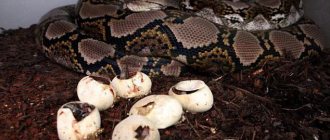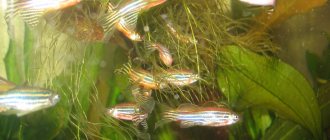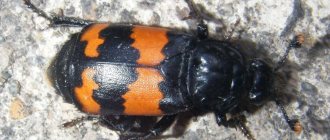How to distinguish a dove from a dove?
To breed pigeons, the first thing you need to be able to do is distinguish the sex of the birds. There are several ways to distinguish a dove from a dove within the same species:
- Appearance. The dove is larger than the dove, its head is large, round with a high forehead, and its neck is short, with a thick base. Doves are graceful, their eyes are more expressive, and the base of their beak is thinner. In ornamental bird breeds, the male is often smaller than the female. Therefore, such signs of gender differences do not work 100%. The pigeon's plumage is often duller than that of the dove.
- Width of the pelvic bones. The male’s pelvis has a narrower distance between the bones, they practically converge, while the female’s has 1.5-2 cm between them. This distinguishing feature does not work for young animals, i.e. birds that have not yet laid eggs, and individuals that have calcium deficiency (their structure may be deformed).
- Bird Behavior: When two males are placed in a cage, their behavior will become aggressive towards each other. This is due to competition, leadership in the seizure of territory.
- If there are two females in a cage, then most often they begin to coo, living peacefully together.
- If birds of different sexes are planted, the dove will begin active courtship: it spreads its tail feathers, inflates its crop, stretches its neck, and chases the dove, trying to hug her. The female's behavior is more calm and measured. If she likes the pigeon, she accepts courtship. In behavior, bows towards the dove appear, nods of the head, feathers fluff up, emphasizing the beauty.
- When lifting the bird by the wings and stroking the chest, the male tucks his paws.
When using sex recognition methods, the nervous state of the birds, breed, and age should be taken into account.
Determining the sex of chicks is somewhat more difficult, since the age-related habits of birds have not yet been formed. However, in some breeds the signs are, on the contrary, obvious. Individuals are clearly separated by feather length and color.
By using the same methods for determining sex within his birds, the breeder is able to determine clear differences between individuals. This is important for the correct formation of the size and reproductive capacity of the flock.
Determining the sex of chicks
Male chicks of most breeds weigh a little more, but the difference can only be seen on electronic scales (1-2 g). Given the restless behavior of young animals, it is difficult to track parameters. External differences are less noticeable than in adulthood, but upon close examination you can see the grace of the doves - their heads are slightly smaller, their beaks and legs are thinner.
You can focus on behavioral factors. “Boys” are more curious - when a foreign object is placed in the brooder, they strive to examine and study it, while “girls” try to move away from the potential threat. Under sound stress, the former take a defensive-observant position, and the latter press themselves to the floor. It is worth monitoring changes in behavior as you grow older. Males become more aggressive and bully each other. The doves behave calmly.
You can conduct a test by lifting the chick off the floor by the scruff of the neck - it is believed that the “girl” will tuck her paws, and the “boy” will hang with his body stretched out. The duration of the check should not exceed two to three seconds.
How do you know if pigeons are sexually mature?
The period of sexual maturity in pigeons begins six months after their birth. However, this does not mean at all that birds can actively begin mating at this age. On the contrary, it is worth giving the female another 6-9 months for the complete formation of all body systems so that the offspring are healthy.
Thus, for natural sexual maturity to coincide with physiological sexual maturity, one to two years must pass. And separating chicks by sex and raising males separately from females is a prerequisite for preventing premature egg laying.
How to choose the right pair?
When selecting pigeons for pairing, consider their temperament. An active male and a timid female are not suitable for each other. And vice versa, nothing good will come of a pair with a lively dove and a modest dove. Their temperament should be approximately the same.
Close relationship among a couple is undesirable, as are similar developmental deficiencies. Birds from the same brood should be marked.
Age
The reproductive capacity of pigeons remains up to 12 years of age. You should not pair up particularly young birds or birds older than 10 years. Chicks are likely to have reduced immunity and low survival rate. In addition, young females often carry unfertilized eggs. And in the case of oviposition with future offspring, they are not able to hatch them.
It is possible to correctly determine the age of pigeons by:
- Woskowice. In young animals it is pink, thin and tender. From 5 months it turns white and thickens.
- The color and condition of the legs. They are smooth and pink in young individuals. With age they become rough and red.
- By century. In adult birds it is white, and in young birds it is almost transparent.
Size and weight
There are no exact requirements for the weight and size of birds before breeding. But it is important to observe feeding habits so that the individual is not underfed or, on the contrary, overfed.
Proper nutrition of birds before mating is very important. One individual requires approximately 50 g of food per day. Don't forget to add minerals in the form of chalk, shell, crushed red brick and coarse river sand. Include minerals and greens in your diet. Let the bird fly a lot.
Do not fatten pigeons before the mating season. This useless measure will not only not speed up the process, but, on the contrary, will create additional problems. Well-fed females often have difficulty laying eggs. And, conversely, a skinny dove will not be able to hatch eggs. Her body is not able to shelter and warm them all. Proper nutrition of birds before mating is very important.
Selection of individuals
First of all, pet owners should decide whether there is a need for breeding Chilean squirrels or not. If the issue of selling puppies has not been resolved, then it is better to postpone degu breeding until the necessary issues are resolved. Otherwise, the house will be filled with a large family of rodents, which will require a lot of effort and financial costs from the owner: the animals must be fed, cages and appropriate equipment must be purchased for them.
Females can mate at the age of 12-14 weeks, males at 16-18 weeks. At this age, animals begin puberty. The female body prepares for fertilization and bearing offspring. They go into heat. Male degus develop reproductive organs.
If individuals of different sexes are kept together, female squirrels may develop early pregnancies. This cannot be allowed. Females must have fully formed reproductive organs. During early pregnancy, puppies are born weakened, with a high percentage of stillborn pups. What are the rules for selecting degus for breeding:
- Individuals aged 10-12 months are allowed to mate. Within a year they stop growing. They reach their maximum weight, their reproductive organs are fully formed;
- they select squirrels from different litters to prevent inbreeding. When crossing squirrels that are related, the intrauterine development of the embryo is disrupted. Puppies are born deformed or dead;
- Only healthy animals without any pathologies are allowed to mate. If parents are diagnosed with diabetes, the disease will certainly manifest itself in their offspring. Rodents with reduced immunity are discarded.
After a group of females and males have been selected, further analysis of the animals is carried out. It is necessary to obtain puppies with certain characteristics. Pay attention to the following characteristics:
- manifestation of aggression; temperamental individuals will give the same emotional offspring; degus with an easy-going character are used for breeding;
- ability to learn; it is recommended to combine females and males that have been tamed by the owner; it is believed that the deguslets will have the same abilities as their parents; they will be easy to tame and train;
- take into account the color of the animals; puppies are given the characteristics of a certain shade of fur; the color of their fur may not change, but individuals are carriers of colored color; the second offspring will already have fur with colored spots; they try to consolidate this sign;
- To obtain a degu with a beautiful shade of fur, it is necessary to carefully select individuals.
The optimal age of rodents for reproduction is 12 months. The weight of a female should be about 250 g. Males - more than 300 g. Pairs are selected from individuals of approximately the same age. A large age difference can affect the development of the embryo. Pathologies most often occur if a young female and an older male are mated. Old age in animals occurs at 6-7 years.
Mating games
The mating season of pigeons begins at the end of winter and continues until the beginning of spring. In the wild, birds choose their own mates. In captivity, this process can take a long time. It takes time for a male to appreciate a female and begin courtship. Due to the strong development of the sexual instinct of pigeons, sometimes you have to wait a long time.
The pigeon shows its sympathy for the dove by actively courting it, circling and inflating its crop, spreading its feathers and hugging it. When accepting them, the female bows and “floats” on her tail. The couple plucks each other's feathers and coos. This means that their offspring can be expected soon.
A pigeon colony often persists and produces chicks throughout its life. This is explained by the fact that these birds are monogamous.
But it happens that a pair does not form due to the fact that the birds do not accept each other. Try to pick up other individuals.
Types of mating and their features
Only healthy, young birds from the same breed, but from different litters, are selected for mating. Pigeons up to 5-6 years old are able to reproduce high-quality offspring, then the chicks become more and more sickly, and the number of congenital defects increases.
Natural mating
Such mating takes place during the free life of pigeons in nature or if the breeder is breeding one breed of birds. There is no need for a person to select a pair and place them in a common box. The dove chooses its own dove.
Pairs form on an ongoing basis, and offspring appear soon. The productivity of eggs, their fertilization and hatching of chicks occurs at a naturally high level. The younger generation turns out to be strong.
Forced mating
Used to preserve and optimize the qualities of the breed. In this type of mating, the pair is selected by the breeder. The individuals are placed in a closed box for the night, and the next day they are released into the aviary with the rest of the birds.
Young pigeons recognize each other and mate most easily. To find out whether the process of pair formation has occurred, just look at the birds. Having shown sympathy for each other and mated, the pigeons will begin to coo among themselves, showing signs of attention and caring for their partner.
Do not remove the box where mating took place; most likely the birds will nest in it. If the couple has chosen a different location, move the box there.
Why don't we see pigeons on the street?
It may seem to city dwellers that the number of pigeons is miraculously increasing; all the birds on the street are adults, but we don’t see chicks anywhere. The logical question follows: do they exist? We can assure you, there are chicks, and there is a great explanation for the fact that we don't see them. To some extent, this has to do with where the birds nest: pigeons usually build their homes in places that resemble caves and rocks. And in big cities they build houses under window sills, on roofs, under bridges. There is another reason why baby pigeons do not appear on the streets. They do not leave their nests from 4 to 6 weeks after birth until they grow up.
Residents talk about pigeons as flying rats, but I would like to note that these birds are very good and responsible parents. The male and female feed and hatch the children together, and if one parent dies, then the second will do everything to raise their offspring, even if it is very difficult for them. So, as a rule, the chicks survive.
When they become old enough to live on their own, they begin to ignore their parents and feed themselves. Young pigeons join a flock of birds and live close to their families. Pigeons also have their own territory where they constantly spend time, and if you take a bird away from there, it will try to return to its usual place.
Nest construction
In nature, wild pigeons build a nest frame from branches. The breeder should take this into account when creating suitable conditions for egg laying on the territory of the dovecote.
For domestic pigeons, you can take boxes or baskets. They are placed sideways or attached to the wall with the bottom, and the floor of the dovecote is covered with dry grass, straw, and leaves. The pigeon pair will create their nest from these materials. The male brings them in his beak, and the female builds the first home for the chicks. Setting up a nest takes approximately 5-7 days.
Several conditions apply to steam boxes:
- They should be kept at a distance from each other. When hanging them on the wall, choose a checkerboard arrangement. This method will help the birds remember the way to their nest.
- It is advisable to paint the boxes in different colors.
- Fix the number of nesting boxes several units more than the number of pairs. This will prevent competition and fighting for boxes among the pigeons.
- Maintaining maximum privacy to create comfort and an intimate atmosphere.
Under no circumstances should you move boxes that have already been occupied by birds!
If there are several pairs of pigeons preparing for the period of hatching eggs, then the nesting boxes should be marked or numbered. This makes it easier to count families and chicks.
Pigeon breeding process
This “event” consists of several stages, which are described in more detail below.
Laying eggs
As soon as the nest is ready, 12-15 days after mating, the dove begins to lay eggs. This process takes 2-3 days. At this time, the behavior of females changes. They become quiet and practically never leave their nest.
The female's cloaca swells. After the first egg is released, the dove can leave the box and return before the second one is released. But he may not do this. Thus, the difference between the chicks hatching is a couple of days.
Hatching eggs
After laying the eggs, the incubation period begins, which lasts 20 days. For the first 9 days there is no need to disturb the dove. On day 10, carefully use an ovoscope to check the eggs for the presence of an embryo in them. If the egg is fertilized, a dark spot and blood vessels will be visible inside. The fertilization of eggs in adult pairs is high - up to 95%, in young pigeon families - about 65%.
Twice a day the male replaces the dove in the nest. During this time, she manages to satisfy her hunger. During incubation, the dove turns the eggs several times so that they warm up evenly.
Female domestic pigeons are very responsible. Hens treat eggs with special care and attention. To facilitate this process, the breeder can maintain a light-thermal regime in the dovecote. And 2-3 days before the chicks hatch, moisten the eggs with warm water. This will allow the shells to become softer, removing dryness, and will help the chicks hatch.
If for some reason the chicks are not born on time, the pigeon couple leaves the nest.
Caring parents throw the egg shells out of the nest.
Caring for chicks
A newborn chick weighs only 10-20 grams. It is practically naked, blind, with a disproportionately large head and a huge beak compared to the body.
In the first 14 days after birth, the offspring feed on milk, which is formed in the female’s crop. This is a special secret of yellow color and curdled consistency. Next, the diet includes grain softened in this way, insects, and remains of plant food.
The firstborn receives its first food approximately 4 hours after birth, and the second chick - 15 hours later. Therefore, they develop differently, and often the weakest die.
After 3 weeks, the chick is already covered with dense plumage, which is replaced by adult feathers during the molting process on days 43-50. After about 55-60 days, the young animals feed on the usual food of the flock, obtaining it independently.
The structure of the bird embryo
In the early stages of development, the body of the embryo is so strongly bent that the head comes into contact with the tail (Fig. 4). When examined, the heads are striking; prominent protrusions of the brain, a large transversely set mouth, neutrally located nostrils connected by grooves to the mouth. In addition, three or four pairs of gill slits attract attention. Note that there are no traces of gills. During further development, the edges of the mouth extend and grow into a beak, the gill slits become overgrown, with the exception of only one pair I, from which the tympanic-eustachian passages develop. Little by little, the head of the embryo takes on a general bird-like appearance. At the first stage of development, both the forelimbs and hindlimbs are almost similar in shape and size. The forelimbs, which have the character of paws, bear three toes, the hind limbs have four. In the forelimbs, with their further differentiation, the second finger surpasses the first and third in growth, and a characteristic bird's hand is formed, turning into the skeleton of the wing; in the hind limbs, the sections of the metatarsals sharply lengthen and a typical structure of avian hind limbs is obtained. At approximately the same time, the feather papillae, located along narrow pterilia, differentiate.
At an early stage of development, numerous blood capillaries appear in the extraembryonic blastoderm, which, growing, cover the entire yolk sac; these vessels play a very significant role in the process of absorption of the yolk by the embryo.
Rice. 4 . A chicken egg at the end of the 9th day of incubation in a vertical section. The embryo under natural conditions lies on its left side on the yolk sac, but is turned over to show its shape more clearly.
1—air chamber; 2—internal, or real, amnion; 3—allantois; 4—hyomandibular fissure; 5—yolk sac; 6—protein.
Preparing for breeding pigeons: choosing a breed
Breeding pigeons can serve different purposes for the breeder. But in any case, you need to approach this process responsibly and prepare for it in advance.
To get started, familiarize yourself with the breeds and choose the one you will practice. Pigeons are divided into:
- Wild. These pigeons are bred for special purposes. Their maintenance requires special conditions. Accustomed to living in the wild, they painfully endure living in cages and enclosures.
- Domestic ones. A very developed area in pigeon breeding. Relatively simple keeping and raising of birds, which does not require special conditions. Moreover, there are many breeds of pigeons in this group.
According to their purpose, breeds are divided into:
- Meat breeds. This involves breeding pigeons for the purpose of eating their meat. Such breeds are larger than their decorative relatives. Pigeon meat is more nutritious and healthier than chicken meat. These include the breed: Roman Giant, Strasser, French Monden, etc.
- Postal (sports). Such pigeons take part in sporting competitions. Breeding these breeds takes a lot of time and requires a lot of attention. Sports breeds: Russian pigeon, German pigeon, English pigeon, etc.
- Decorative. Used in the circus, landscape design, at exhibitions, at weddings and other celebrations. They are sold and rented. Breeding such pigeons is more difficult, and the costs are higher than when breeding meat breeds. Popular breeds: German Monk, Peacock, Jacobin, etc.
Knowing these differences, choose the breed you like, taking into account your breeding goals, preferred size and plumage color. Next, prepare the conditions for breeding birds and you can purchase young animals or pairs.
The structure of the blastoderm
In a recently laid egg, the blastoderm, or germinal plaque, is divided into two sections: a central, light area and a marginal, dark area. The blastoderm is composed of an outer layer of ectoderm cells, as well as an irregular deeper cell accumulation, which differentiates into mesoderm and endoderm (Fig. 3).
The blastoderm grows gradually, peripherally, enclosing the yolk and at the same time being divided into the embryonic section, from which the embryo develops, and the extraembryonic section, covering the embryo sac and not directly participating in the formation of the embryo. The ectoderm and endoderm grow regularly and symmetrically, but the mesoderm initially gives two lateral processes open in front, which close only later.
At this stage of development, we see, examining the blastoderm under a microscope, in its middle part there is a primary groove (Fig. 3, A, 4), corresponding to the closed slit-like blastopore of the amphibian embryo, and immediately in front of it, an ectodermic medullary groove, from which it subsequently develops nervous system (Fig. 3, A, 5).
Rice. 3. Diagram of a chicken embryo at 20-24 hours of incubation.
A
— diagram of the blastoderm of a chicken egg around the 20th hour of incubation (enlarged 8 times): 1 — light field; the white area consists only of ectoderm and endoderm, and in the posterior part of the pear-shaped area, covered with a light dotted line, mesoderm is also developed; 2—dark field; 3—mesoderm border (dashed line);
4—primary stripe; 5—neural plate—the first rudiment of the central nervous system. IN
—blastoderm of a chicken egg around the 24th hour of incubation (enlarged 8 times): 1—light field;
white area (proamnion)—ectoderm and endoderm; the pear-shaped area covered with a dotted line is the mesoderm; 2—dark field; 3—the border to which the mesoderm reaches; 4—forming forebrain; 5—nervous groove; 6—mesoderm somite, or primary vertebra; 7—primary stripe. y
—chicken embryo at the 24th hour of incubation (increased 20 times): 1—nervous fold; 2—nervous groove; 3—wood strip; 4—edge of the bright field; 5—mesoderm somite; 6—vitelline vein; 7—head of the embryo.
Differentiation of the vertebral plate and primary vertebrae, or somites. Subsequently, the vertebral plate, or the dorsal section of the mesoderm, delimiting the medullary groove, differentiates. The vertebral plate breaks up into primary vertebrae, or somites (Fig. 3, B, 6); at the same time, the abdominal section of the mesoderm splits and a coelomic cavity appears here. The dorsal chord develops along the midline, under the medullary groove, from the endoderm layer.
Note that the primary and medullary grooves lie at right angles to the long axis of the egg; the blunt end of the egg is to the right of the developing embryo.
Breeding a new breed
If you want to develop a new breed through experiments, you should select a pair of birds of different breeds. All other stages are similar to the forced type of mating. Keeping a diary by the breeder in this case is a necessary condition.
The process of breeding new breeds requires special knowledge and a large amount of information. It is better to do this, achieving positive results, if you have experience in breeding pigeons of the same breed.
We recommend reading the article on how to properly breed pigeons.
How many times per season do pigeons give birth?
After a month, regardless of whether the chicks have flown out of the nest or are still in it, the parents leave them. The pair occupies a new nest and the process of laying eggs and incubating offspring is repeated. Thus, during the season, pigeons give birth to offspring up to 4 times.
So, before you start breeding pigeons, you should familiarize yourself with a lot of information: what breeds there are, the purposes of their breeding, mating methods and other features. Prepare living and breeding conditions for birds. Complete all papers and permits. The process is labor-intensive and costly. But pigeon lovers are ready to go through all the difficulties to ensure that the flock is as happy with its offspring as possible and is healthy.
0
0
Copy link
